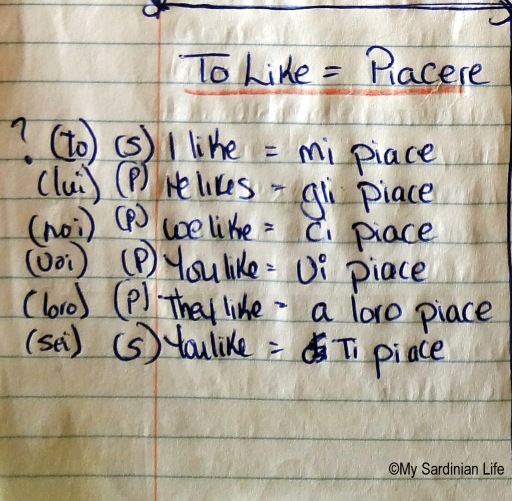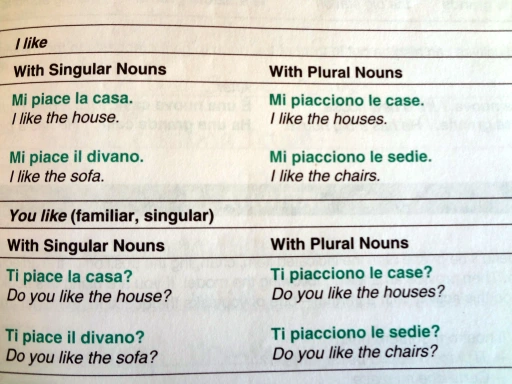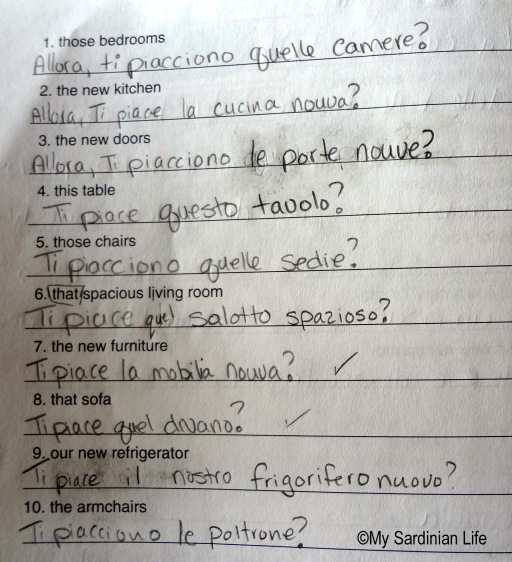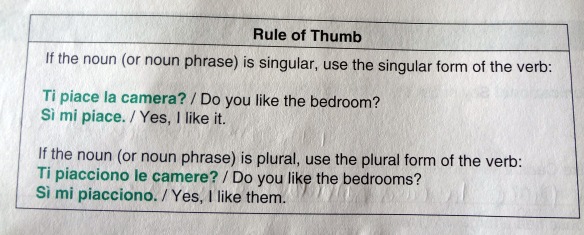Welcome back for another installment of Learning Italian with Jennifer Avventura. This week we take a close look at the verb to like – Piacere. I hate this verb with every fiber in my being. I started to study Italian 5 years ago using a fabulous work book called Italian Now Level 1 by Marcel Danesi and I have just dusted it off in hopes to get this one verb mastered. This book has been a god send and I recommend it to anyone who is just beginning to learn Italian.
Piacere – to like

I’m tired of asking people “piace?” when I should say “ti piace” or “vi piace” depending on whom I’m speaking to.
Then things get really confusing if the noun is plural, not only do you have to change the article, you also have to change the noun and the verb! In English we have one article ‘the,’ however, in Italian there are seven and they are gender specific – il, i, lo, l’, gli, la, le.

Here’s a little exercise I did using the verb ‘piacere.’

Can you see all the eraser marks? It wasn’t an easy chapter to master and I’m still learning the basics of this very difficult verb.
Here’s a little hint:

Are you left confused by all this madness? Don’t worry, so am I.
Non mi piace il verbo piacere. Non e facile a imparare questo verbo e la mia testa gira quando devo pensare per piacere! Pero, mi piace mangiare pizza. Vi piace mangiare pizza?
How did I do above?
Can you offer any advice on how to master this difficult Italian verb?
For more in this series:

I feel your pain. I’ve been learning French for several years and I have never mastered the grammar. I just hate sitting down trying to learn it. I havn’t mastered the vocabulary either….I am currently trying to read a novel in French and I was on the train today struggling through a passage involving an interaction between a man and a woman, not really comprehending it. I noticed that a male passenger was reading it over my shoulder and smirking…….that’s when it dawned on me that I was struggling through a steamy sex scene…..lol……try some Italian novels…..and search for phrases such as ‘do you like this?’….’I like it’ …..’.what do you like’ ….’She used to like it!’….that might help you to remember ……lol !!!!!
That’s the best advice ever! 🙂 Thank you.
I’ve taken Italian classes for 6 months and I have a permanent headache. Luckily, I pick up pieces here and there when my husband talks to his parents over Skype. I tend to pick up more when I’m visiting Sardinia…. however, after a few weeks back home, I lose it. I need to dust off my books between classes and study. Thanks for all of the great tips!
Did you see the Canadian Blog Results are up? Different format this year… it doesn’t go onto a round two or show you the placement…. just the top 3.
Congrats you made it to the top 3. 🙂
Oh – wow, I haven’t even had the chance to look. 🙂 Thank you.
Yes I looked everyday and then was disappointed 😦 I did better last year. Oh well I’ll try again next year.
Great post, Jennifer, and a wonderful series. I think I won’t even attempt Italian until I have mastered Spanish.
Hugs from Ecuador,
Kathy
Holy cow! This reminds me a lot of the equivalent in Spanish, ‘gustarse’ (I think …), which gave me a mental block all throughout my Spanish courses in my undergrad. So grateful right now for the (relative) simplicity of Dutch grammar!
Hello Jennifer! I’m from Sardinia and I love your blog 😀
I’ll try to explain the usage of this “strange” verb, if this helps with your struggle with Italian!!
Please, forgive me for my bad english! I’ll try to do my best!
Umbriascribe’s comment makes sense, it is a perfect advice. “piacere” does not exactly translate “to like”.
Let’s consider the sentence “Mi piace la pizza” = “I like pizza”;
Now, look for the subject in the two sentences: In the english sentence, “I” is the subject; in its
italian translation, the subject is “pizza”. So it is reversed! But, why? Because, as umbriascribe
said, piacere is more similiar to the verb “to please”. There’s also another important difference: as you know, “to like” (as well as “to please”) is a transitive verb (so it can have a direct object,
“pizza” in this case), but “piacere” is an INTRANSITIVE verb.
For those reasons, the direct object in the english sentence becomes the subject in the italian
sentence (similiar to “to please”). The english subject is the “complemento di termine” in italian, that, here, tells you who likes “pizza”!
“A me/Mi” doesn’t mean “me” (direct object) but “to me” (indirect);
I – like – pizza = subject – verb – direct object
Mi – piace – la pizza = indirect object – verb – subject
A me – piace – la pizza = indirect object – verb – subject
“Mi” is the same as “A me”, but “Mi” is the most common form, unless you want to emphasize the person who likes pizza, in this case “me”.
Another way to write the same sentence, but not a very good way to do it, is:
“La pizza – piace – a me” = subject – verb – indirect object
Here you have to use “a me” instead of “mi”, because it follows the verb (don’t ask why, I don’t know 😀 , it’s the rule)
In the sentence “La pizza piace a me”, the order is the same as in english (subject first), but it is a very strange form (if you use this order, people can tell immediatly that you are a foreigner); I don’t know why, but I guess it’s because the person who “likes” is more important than the object itself , somehow.
Another example:
“He likes me” = “Io piaccio a lui” or “Gli piaccio”: the subject, in italian, is “me = io” instead of
“he = lui” (it has the same structure of “I please him”).
“Does he like me?” has to be translated as “Gli piaccio?” or “io piaccio a lui?”.
“Lui mi piace” doesn’t mean “He likes me”, but the opposite: “I like him”!
You can see that the italian subject can be very hard to find, because it can follow the verb or even be omitted. There’s a simple way to find it, anyway, but let me tell you this, first.
Maybe, there’s another thing that can cause terrific confusion. Look at the first photo in your post: on the left, you have the conjugation of the verb “to like”, present simple. The right column (the one in italian) IS NOT the conjugation of the verb “piacere”, but it’s just the translation of the sentences on the left (because, I repeat it once again, piacere is intransitive and its structure is more similiar to “to please”).
I’m sure you already know this, but anyway, the conjugation of piacere, present simple, is:
Io piaccio – 1st person singular – I please
Tu piaci – 2nd p.s. – You please
Egli/Ella piace – 3rd p.s. – He/She/It pleases
Noi piaciamo – 1st person plural – We please
Voi piacete – 2nd p.p. – You please
Essi/Loro piacciono – 3rd p.p. – They please
Now, the trick to find the subject in an italian sentence is: always look at the verb first!!
It tells you if the subject is 1st/2nd/3d person, singular or plural, because each has a different
form!
Examples:
“Mi piace la pizza”:
The verb is piace = 3rd person singular; “Mi” can’t be the subject of course (as it means “to me”), so “pizza” must be the subject.
“Gli piacciono quelle sedie”:
The verb is “piacciono” = 3rd person plural; again “Gli” can’t be the subject, but “quelle sedie” is
plural and it’s 3rd person, so it must be the subject.
What if the sentence is “Mi piaci”?
Here, the subjects is hidden ‘inside’ the verb. “piaci” is 2nd p.singular, so the subject is “you”, and the sentence translates “I like you”.
The words “mi, ti, gli/le, ci, vi, a loro” stand for the person they refer to:
Mi = A me, translates to me;
Ti = A te, translates to you, singular;
Gli/Le = A lui/a lei, translates, respectively, to him/to her; (“to it” can be translated with “gli”)
Ci = A noi , translates to us;
Vi = A voi , translates to you, plural;
A loro*, translates to them;
*In spoken italian only, we often use “gli” for “a loro”, but it is formally wrong;
I hope this explanation is somehow intelligible I’m not sure about it!!! 😀
I’m not sure about it!!! 😀
Anyway, I’m here, just ask!!
Don’t give up!!! Kisses
Gosh, you are super! Thank you for this great advice! 🙂
I hope it helps you!! Happy Sunday 😉
It’s a very BIG help! Grazie mille. 🙂
Wow Ivana!! Perfect 🙂
It ISA confusing verb for English speakers. It really translates as …it pleases me, rather than I like.
Oh don’t! I don’t think I’ll ever get there with Polish 🙂
Jennifer
Thank you for your insight and the title of the book. I will order this one. When I was taking Italian lessons, the verb usage confused the heck out of me, now I don’t feel alone in that! Have a great day!
Love,
Rosemarie
The Sard/American
So jennifer…
Non mi piace il verbo piacere. Non e facile (( DA) or just leave it out ) imparare questo verbo e MI GIRA LA TESTA quando ( CI ) devo pensare. Per piacere! Pero, mi piace mangiare pizza. Vi piace mangiare pizza?
Much Better like this 😉
By the way Io gli piaccio ? is – Does he like me ?
Saludos
Great, thank you Bruno. 😉
Prego 😀
Oops, you’re right. It’s “Do I please him?” (for does he like me?). Egads. See, Jennifer? I’m still making mistakes! Thanks, Bruno!
You’re welcome, I hope I don’t come across as a Mr know it all… I learned Italian when I was twelve so I’ve had time to learn it well. 😉
No, I certainly don’t! I appreciate all the advice, heck, I need it! 🙂 Thank you.
Mi piace! 🙂
This is one of the toughest verbs to learn and to “get” for us native English speakers because we think in terms of “liking something” rather than having something please us. Which is really how you must get your head around this verb. Once you put the subject in the place of doing the pleasing (whether it’s cats or furniture or a person/people)…singular or plural becomes easier. So, instead of “do you like pizza?” Think of “does IT please you, THE PIZZA?” (Ti piace la pizza?). Or, “do THEY please you, THE CATS?” (Ti piacciono i gatti?). Then…you get into the really tricky bits. “Do you like me”? You must think this way: “I please you?” (Ti piaccio?) “Does he like me?” Easiest way is to think “He likes me?” (Lui mi piace?) It gets more complicated but for now, these basic principles should work for you. This one just took a lot of memorizing and repeating. Good luck! You asked how you did on your sentences at the end…one little nit. Don’t ask me why, but it’s “Non e’ facile da imparare… again, the articles are THE worst to learn and just take a lot of memorizing. I still make mistakes and probably always will! Hang in there…you will get it!!
Thank you for this fabulous advice!! I’m even more confused now, but with enough practice Ill get it. Thanks! 🙂
Does it mean “to please”, i.e. you say “[something] pleases me”? Same in Spanish. I’m fine with it now, but, it turns out, in Portuguese you use the same verb as in Spanish (gustar), but in the same way you’d use “like” in English. NOW I’m confused 😉
Yes, yes. It does also mean ‘to please.” The moment I have to speak in plurals my tongue gets all twisted. 😉
Sorry but I can’t offer ANY advice…I just kind of go with “what sounds right!” I’m pretty sure my background with French (i.e., verbs) helped me master Italian while I was living there…although it DID take a LONG time!
It seems to be taking me forever to get it right! I think if the locals spoke only Italian it would be easier! 🙂
In addition, here ‘in the south’ of Sardegna they also use ‘a mi piace’ just to make things more complicated. I see no compelling reason to be so precise, lol but i suppose when I have to take my drivers test….
Will buy the book, thanks so much Jennifer, been going to Sardinia for 10 years now, and can still only manage to say the basics, hello goodbye, and order a beer and a pizza – and where our house is very few people speak any English – I carry a little phrase book with me everywhere I go, and usually end up pointing to the word, after they haven’t understood my 1 word.
You will enjoy the book, it’s been extremely helpful for me. Good luck! 🙂
I completely agree I loathe this verb – but how do you say, does he like me? Hours wasted trying to get this into my head! I’ll find another way to say it! Thanks for sharing the pain 🙂
Non lo so come si dice “does he like me.” Lui mi piace? BOH! I’m glad I’m not the only one suffering over this verb. 🙂